 Back to
essays page.
Back to
essays page.For many years archaeologists have worked to dispel the Victorian image of Vikings in horned helmets. But now the battle is almost over it is interesting to look again at their origin. The material is fascinating in what it has revealed about early English religious beliefs, and deserves investigation.
The most famous examples are from the silver-plated, embossed bronze helmet plates ("pressblech") on the Sutton Hoo helmet (fig (i)), although there are many others.
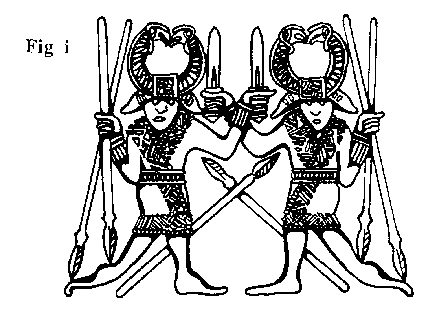
The commonly stated explanation for these figures is that they depict figures engaged in a ritual or are themselves intended to be of some religious significance.
This is fine, but not very illuminating! What exactly was this "religious" function?
The earliest depictions of horned men in the North come from the Neolithic period. Rock-carved figures of many types occur throughout Scandinavia. One particular carving from Rodoy in Norway depicts a horned man who appears to be either paddling a canoe or skiing - possibly on a journey to the "Otherworld’ if you believe the explanation that these figures depict shamans. Fig (ii).

Another figure found depicted in Scandinavian rock carvings from the Stone and Bronze Ages and also as small figurines, is the horned bull. These bulls often have small balls on the tips of their horns, and are associated with depictions of ploughs, ships and snakes. The bull is taken to be a symbol of strength, fertility and majesty. Occasionally its horns meet, forming a circle suggestive of the sun-discs with which it is often also linked.
It is to the Bronze Age that two magnificent helmets found at Vikso on Zealand are attributed. Their smooth, curving horns are unmistakably those of a bull, whilst their ridged crests bear the heads of birds of prey. Fig (iii).
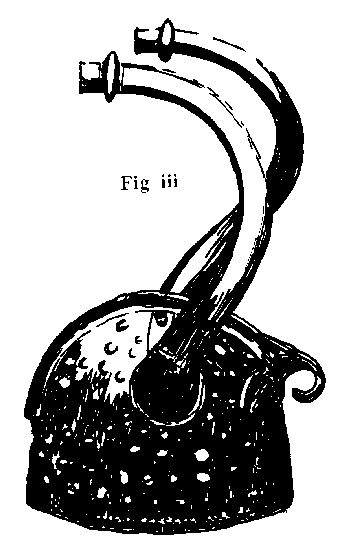
A small bronze from this period, of a pair of kneeling men wearing just such headgear was discovered in Denmark in the 18th century. Only one survives now, although drawings were made at the time of their discovery. The men were kneeling side by side, naked except for belt, neck-ring and helmet - a fact reminiscent of the Danish Iron Age bog-body known as "Tollund man" whose preserved corpse was bare but for his leather belt and hat and the noose which strangled him. Unlike Tollund man, however, the bronze figurines carried axes in their outstretched right hands. Fig (iiii).
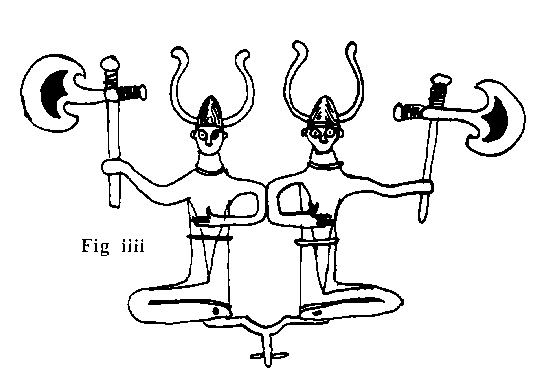
Throughout the Bronze Age, religious iconography in Scandinavia gradually shifted its focus as increasing emphasis was placed on sky imagery with representations of the sun-wheel and the axe (usually attributed to the Indo-European thunder-god) becoming most prominent. There is a concomitant decrease in the more primitive, shamanistic religious imagery. Over a large part of Europe, Africa and Asia, the bull became another symbol of the sky-god, bull sports becoming a significant part of the religious ceremonies of the god.
It is in the Celtic Bronze and Iron Aces that horned-man imagery is at its height in this country. Stone heads with horns of varying type - usually ram - are found throughout Britain and the continent, although to my knowledge they are rare in Scandinavia. A famous bronze horned helmet from this era was found in the Thames at London. Interestingly enough however, perhaps the most popular depiction of the horned deity of this period - that on the Gundestrup silver bowl - is now not believed to have originated in Northern Europe at all, but instead to be the work of itinerant Scythian metalworkers from Rumania, the iconography being North Indian and Persian rather than European. A dead give-away is the depiction of two elephants on one of the panels!
Throughout the time of the Roman occupation of the West, depictions of horned men in the traditions outlined above are rare, although not non-existent. A horned nude figure, such as that from a crude stone carving at the fort of Alauna at Maryport in Cumbria (fig (v)), is often identified as the Romanised god Belatucadrus ("Bright Shining One"). However, with the advent of the Migration period, they again make an appearance in Europe: Two magnificent golden horns, dating from the 5th century or earlier were found at Gallehus in Denmark 200 years ago. A runic inscription around the lip of one seems to indicate its northern manufacture. Each horn was covered in figures of men, animals and fabulous creatures, although only one panel need interest us here. On the top panel of the runic horn are two figures, naked or wearing loincloths, who have helmets (or strange hairstyles/headress) with long, curved horns sprouting from them. One holds a sickle and a pointed rod, the other a short spear, a ring (or possibly a shield) and a rod. On either side is a warrior wearing a neck-ring and naked to the waist. Between the pairs of men is an animal, which is either a horse with crescent-shaped horns, or a stag. The sickle, spear and possible shield could link them with hunting, fertility and war. Fig (vi).
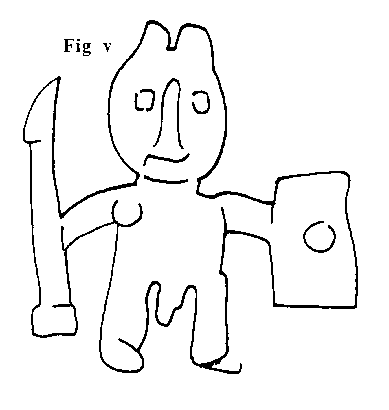

It is interesting to note the pairing of the horned men on the drinking horn, the bronze axe-wielding figurines and the Vikso helmets. Together with the paired dancing warriors from the Sutton Hoo pressblech, it is possible that there is an association with the ‘twin gods" mentioned in Tacitus’ "Germania" who are noted as sons of the sky-god. Tacitus calls these the "Alcis", and states that they were venerated by a tribe known as the "Nehevali" in a forest sanctuary. Other ancient writers state that they were worshipped by tribes near the North Sea.
Horned horses also appear on another set of Migration-period finds; gold bracteates. These medallions, ultimately derived from Roman originals hearing depictions of the Emperor s head, Victory crowning a hero etc. have by the 5th century onward become lucky charms - as evidenced by runic inscriptions such as "I give luck" - in which it is difficult to see anything Roman at all.
One particular "family" of bracteates shows a man on the hack of a horse, which bears horns Upped with discs. Often the hair of the rider trails from the back of his head to form an eagle’s head. Swastikas (an ancient lndo-European sun-symbol, later thought to be associated in Germanic contexts with thunder) are often found in the design, and sometimes the animal is not a horse, but rather a wolf or a dragon. Fig (vii).

Another family of bracteates often shows a dancing youth, naked except for belt and hair/headresses This links in with the next, and perhaps best known, aspect of the case - the Vendel period pressblech. The dancing youth appears on one of the 6th century dies for making pressblech from Torslunda in Sweden. He carries a spear in each hand, a sword in a scabbard on a baldric, and his only apparel is a belt and horned headgear. See fig (viii). By now the picture should be familiar! One of the interesting aspects to this die is that it is one of the first appearances of birds of prey’s heads tipping the horns, although, as I have mentioned, a bird of prey is frequently associated with horns and dancing men. It is sometimes stated that the figure is one-eyed. From close inspection of the die itself, I cannot categorically agree with this - it may just be a casting error though if it were intentional then there would be an obvious affinity.
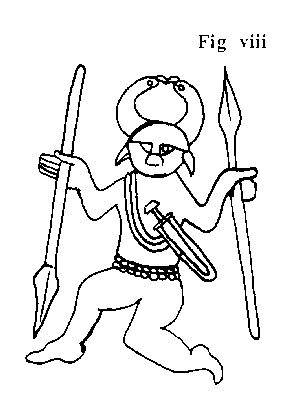
Moving on to the pressblech proper we come forward to the end of the 6th century and into the early 7th.

A pair of dancing warriors, this time clothed in wrap-around tunics, but again with a sword on a baldric and pairs of spears, comes from the 7th century grave 7 at Valsgarde, Sweden. This plate is iconographically identical to the Sutton Hoo fragments shown - again coming from a 7th century grave - although it is stylistically dissimilar. Another scene in which the horned man appears from the pressblech of Valsgarde 7 and also 8 is that of a horseback warrior whose spear he guides or hinders -associating him possibly with the outcome of battles. Whether it is intended to be the battle-god himself or just a minion is unclear. Interestingly’ the Sutton Hoo fragments which also depict this scene omit the horns from the entity guiding the spear. Fig (ix).
Further examples from England include the following:
A fragment of pressblech from a robbed tomb at Caenby in Lincolnshire, similar in style to, but not the same as those from Sutton Hoo. Fig (x).

A late 7th century buckle from a male grave in the Anglo-Saxon cemetery at Finglesham, Kent depicts a dancing man carrying two spears and wearing only a belt and horned helmet. The horned headgear appears to bear "spectacle" eye-guards - which are reminiscent of the Vendel & Valsgarde class of helmet mentioned above. It is noteworthy that the Finglesham man’s pose is very similar to the massive figure cut into the Sussex chalk downs, known as the ‘Long Man of Wilmington". This area being first cultivated by the Saxons, as far as is known, it is suggested there is some parallel, and that the Long Man is the ultimate expression of this religious figure. Fig (xi).
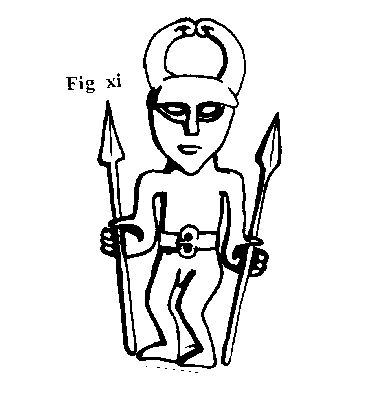
Grave 138 at the Finglesham cemetery revealed a small (25cm) cast bronze head bearing bird-headed horns and a splendidly doleful moustache! Fig (xii).
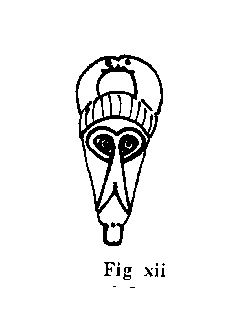
The final English example also comes from Kent, this time from the Buckland cemetery. Grave 161 (female) held a large (13cm) pin topped by an anthropomorphic head bearing very stylised bird-headed horns. Fig (xiii).
The last European appearance of the horns comes from a late 7th century Christian gravestone at Niederdollendorf, Germany. On the one side is a large crescent tipped with bird heads. On the other appears a naked man standing and holding a spear.
Whilst Christian Europe forgot the figure - except, perhaps to transmute him into the medieval vision of the Devil, Scandinavian paganism continued to remember him throughout the Viking Age.
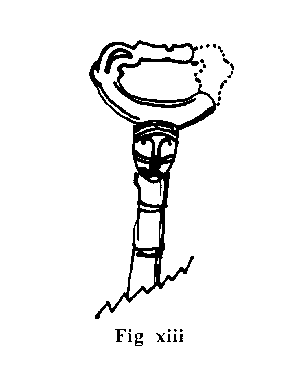
In the rich ship-burial at Oseberg, Norway, the famous tapestry shows two separate horned figures. They both wear baggy trousers or a centre slit tunic, however the horns of one curve in crescent fashion, and of the other clearly follow the curves of a bulls horns more like the Bronze Age images than the bird-headed later depictions. The former carries a sword outstretched in his left hand by the blade or scabbard and is closely accompanied by two birds (ravens?) and a spear, the other’s right hand is missing but bears two spears in his left and is associated with one bird, an arrow and possibly another spear. Fig (xiv).

The only other Viking depiction is a small, silver model from a grave at Birka, Sweden. It is 2.9cm high and depicts a man wearing a belted tunic, holding a sheathed sword in his left hand and a rod (or possibly a broken spear) in his right. His horns meet at the top to form a complete ring in the manner of the Finglesham pendent. Fig (xv).
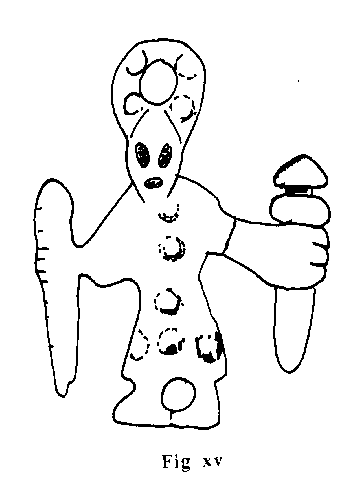
So clearly the horned man has had a varied history - spanning the entire length and breadth of our pagan English, Germanic and Scandinavian past, and to reiterate my original question, what was his function?
To begin with he is associated with shamanism, but, with the emergence of theism assumes a relationship with the axe and bull of the sky-god. His relationship with the sky-god is strengthened with the appearance of the birds of prey (eagles?) and crescent-moon shape to his later horns. Later still, the sword and the spear in particular may tie him to a god of battles or warfare. In the Iron Age this would be Tiw or perhaps *Tiwaz to give him the name hypothesised for the period. There can be little doubt that at the end he is closely associated with Woden.
So, the dancing, horned man probably meant many things to many people at many different times. By the time of his appearance in England in the 6th and 7th centuries his depiction is most likely to have thought to have bestowed luck, and perhaps particularly luck in battle (although his appearance in a female grave would perhaps indicate that this is not exclusively the case). Tacitus may have stumbled across some of the rites associated with him in the 2nd century when he states in Germania (24)
"They have only one kind of public show, which is performed without variation at every festive gathering. Naked youths. trained to the sport, dance about among swords and spears levelled at them. Practice begets skill, and skill grace; but they are not professionals and do not receive payment. Their most daring flings have their only reward in the pleasure they give the spectators."
There may be little connection between all these items. I am particularly uncertain as to whether the series of Celtic and Romanised Celtic artefacts derived from the same traditions. For the same reason I have excluded famous Palaeolithic depictions such as the ‘sorcerer’ from Les Trois Freres etc.
One thing is clear - horns were a particular symbol associated with certain religious ideas throughout Northern Europe and Scandinavia, and that, for a time, sections of pagan England revered the horned man as a representative of powerful supernatural forces.
SELECT BIBLIOGRAPHY.
1. HRE Davidson, "Pagan Scandinavia" London, 1967.
2. HRE Davidson, "The Battle God of the Vikings", University of York Medieval Monograph Series, 1972.
3. S Chadwick Hawkes, HRE Davidson & C Hawkes, "The Finglesham Man" in "Antiquity" XXXIX, 1965.
4. H Norling-Christianson, "The Vikso Helmets" in "Acta Archeologia" XVII, 1946.
5. R Bruce-Mitford, "The Sutton Hoo Ship Burial" Vol II "Arms, Armour and Regalia", London, 1978.
6. R Hutton, "The Pagan Religions of the Ancient British Isles", Oxford, 1991.
7. Tacitus, "Germania", trans. H Mattingley. Revised SA Handford (together with "Agricola"), London, 1970.